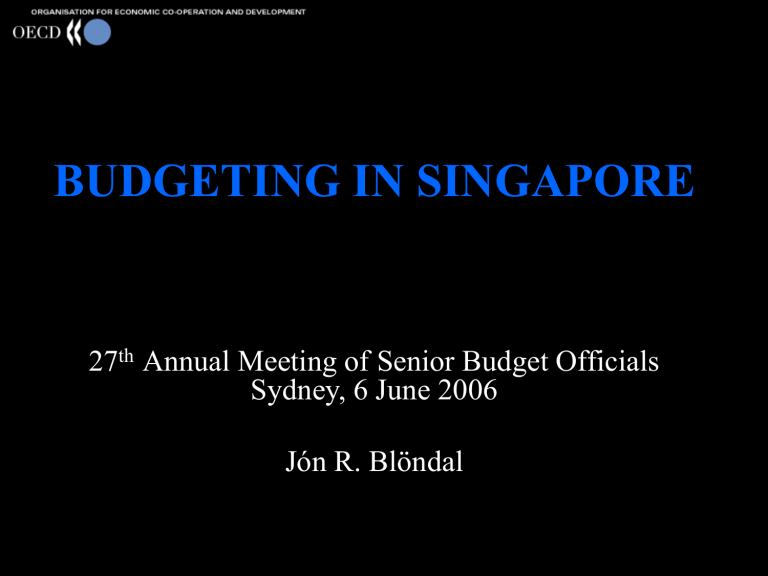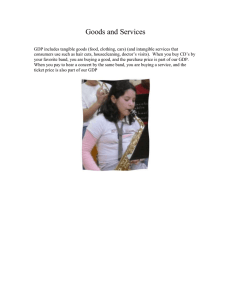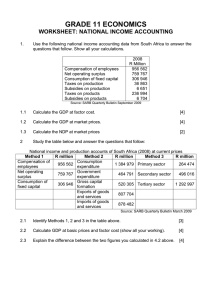BUDGETING IN SINGAPORE 27 Annual Meeting of Senior Budget Officials

BUDGETING IN SINGAPORE
27 th Annual Meeting of Senior Budget Officials
Sydney, 6 June 2006
Jón R. Blöndal
To begin…
• “Profile”
–More descriptive
•
OECD Asian Centre for Public Governance
–Government of Korea
Agenda
•Outline the architecture of Singapore’s system of public finance
•Discuss key features of Singapore’s budgeting system
Budget Concepts
•
Four Pillars
–Budget sector
–Central Provident Fund
–Government investment agencies
–Other special funds
Central Provident Fund
• Relieves budget sector from financing various social services
•
Personal savings accounts
–Mandatory
–Payroll contributions from both employers and employees
•33% of payroll
–Earn interest
–Withdrawals for approved uses
–Any remaining balances form part of estate
• CPF “surpluses” invested in government bonds
Central Provident Fund (2)
• Housing account – 20%
–For down-payment and servicing mortgages
• Retirement account - 6%
–Regular withdrawals from age 62
•
Medical account - 7%
–For hospitalisation and major outpatient treatments
Government investment agencies
•
Huge reserves
–Past budget surpluses and CPF “surpluses”
–At least USD 160 billion
• Invested in financial instruments and corporate shareholdings
•
Very limited disclosure
–Portfolio size, composition and rate of return not disclosed
•“To prevent market speculation”
–Differentials in rates of return vis-à-vis interest paid on CPF account balances
• “Ring-fenced” from budget sector
Other Special Funds
• “Netting” funds
–Example: Government Securities Fund
•
Endowment funds
–Budget surpluses deposited in them
–Subsequent annual investment income used to pay for good causes
–Example:
MediFund
–
25
20
Total Revenue
15
10
5
–
Total Expenditure
Budget Balance
0
-5
-10
FY86 FY88 FY90 FY92 FY94 FY96 FY98 FY00 FY02 FY04 FY06 (Bud)
Key Features
•Fiscal rule
•Block budgets
•Reinvestment dividends
– •Role of Parliament
•Financial management
•Government salaries
Fiscal Rules
• Balanced budgets
–Over government’s term of office
•
Limited use of investment income
–Up to 50% of realised income
• Enforcement
–External monitoring not feasible
–President as “fiscal guardian”
–
Block Budgets
• Five-year horizon
–Advances and carry-forwards
•
Linked to GDP
–Budget pegged to share of GDP
•Ministry of Education = 4% of GDP
–“Smoothened” GDP
•
Fungible
–One block per ministry
–Operating, transfer and capital expenditure all in one block
–
Reinvestment Dividends
• Across-the-board cuts in expenditure
–5% of all expenditure, i.e. including transfers and capital expenditure
• Ministries make bids to “reinvest” the cuts
–Innovative proposals
–Inter-ministerial co-operation
•
Significant part of cuts not “reinvested”
–
Role of Parliament
•
Specific restrictions
–MPs can only make proposals for S$100 nominal cuts
–MPs cannot make proposals for any increases or reallocations
•
Political environment
Financial Management
• Accrual financial reporting
–Greater awareness of non-cash costs in decision-making
•
Cash budgeting
–Better control
–Supplementary information on accruals available
•
NEV – Net Economic Value
–Incorporates cost-of-capital
Government Salaries
•
Pegged to private sector equivalents
–Ministerial salaries (USD 500,000-1,500,000)
•
Flexible wage system
–Responsive to economic conditions
•
Strengthening link with performance
• “Pure cash” wages
BUDGETING IN SINGAPORE
27 th Annual Meeting of Senior Budget Officials
Sydney, 6 June 2006
Jón R. Blöndal






